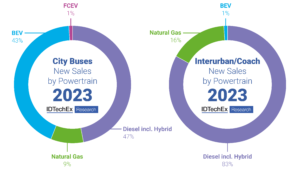Electric buses are booming, with sales growing in Europe, America, India, and other key regions. Transport operators have shown themselves keen to electrify urban transport and cut greenhouse gas emissions. As emissions regulations tighten, city buses are likely to be all-electric within the next few years. IDTechEx’s report, “Electric and Fuel Cell Buses 2025-2045: Markets, Players, Technologies and Forecasts”, shows that over half of all city bus sales in Europe in 2023 were electric (battery and fuel cell) and that some regions are well ahead of the EU’s target for 100% of new city buses to be zero emission by 2035. However, in the coach segment, only around 1% of sales were electric across the same period, so what is driving the excellent growth in the city segment, and will it be replicated for coaches?

City buses are the perfect candidates for electrification
Buses were one of the first transportation sectors to demonstrate that they could be completely electrified. In China, sales began at pace in the early 2010s and reached a peak in 2016 when almost 140,000 electric buses were sold in a single year. While the sales figures have since declined and then plateaued – the overall bus fleet is now over 77% electric. With over 3 quarters of buses electric, these are not pilot projects or early successes but established incumbent technology. Electric buses now have well over a decade of use, transporting millions of people safely and efficiently. But what are the unique aspects of city bus transport that have allowed electrification to outpace other bus sectors?
Predictability: City buses, by their nature, follow predetermined routes with set schedules every day that they are in service. For electric buses, this means that routes can be optimized such that range anxiety is effectively removed. Compare this to a private passenger car, where the daily mileage might vary substantially, and routes longer than the range of the vehicle may be desired.
Opportunity charging: City buses are typically confined to a single metropolitan zone, and to be useful, transit services must stop regularly for passengers to embark/disembark. This presents a perfect chance for opportunity charging, where either overhead pantographs or wireless charging can quickly top up the batteries. This allows operators to potentially use a smaller Li-ion battery pack yet achieve the same range. This brings cost and weight savings.
Concentration of infrastructure: Buses are typically parked overnight in depots, and many buses may use a single site. This allows for the concentration of infrastructure, as building out grid capacity for a single site may allow the charging of an entire fleet of buses. Buses typically operate during the day, meaning they have a much longer period to charge. Thus, lower-level trickle charging can be used rather than grid-intensive fast charging – this also slows the battery degradation. When the busses are operating the daily routes, this infrastructure can then be utilized by other vehicles such as public charging or eLCV fleets. This generates revenue for the bus operator and recoups some of the investment in the infrastructure.
In summary, electric city buses are here to stay. They have demonstrated that they can operate in a wide range of conditions – with buses in operation from Northern China to Southern Spain. With correct route optimization and clever infrastructure utilization, they can comfortably operate most routes operators require.
What about coaches?
While city bus sales have turned increasingly electric, the coach market, by contrast, is stagnant and almost entirely diesel. IDTechEx research has assessed some of the challenges that hold back electrification, both technical and economic.
Range: One of the larger technical hurdles to overcome is range. Although energy density improvements have allowed onboard battery storage to increase, electric vehicles still have shorter ranges than their ICE counterparts. As battery pack size increases, weight and volume become a challenge. Improvements in energy density can help overcome this, but current state-of-the-art packs are insufficient to provide adequate range. Coach journeys are typically much longer and travel interurban, intercity, and even international routes. As such, the limited range is a much greater challenge than that of a city bus, which may have a much lower daily required mileage.
Charging infrastructure: These coaches will typically leave built-up areas behind and travel long distances on highways without stopping. As recharging will be required, the necessary highway infrastructure needs to be put in place for coaches to recharge en route. Unlike city buses, which can charge slowly overnight, these coaches are likely to need fast charging to avoid passengers having to wait multiple hours in a remote service station, which would increase journey times and reduce customer satisfaction. The non-concentrated nature of coach travel (fewer coaches will travel to a much wider range of destinations) means that more charging infrastructure will need to be developed.
Funding: Currently, battery electric buses are about twice as expensive as a comparable diesel bus. While large metropolitan transport operators may be able to afford the investment, regional coach transport operators are often much smaller entities and thus struggle to absorb the increased costs associated with electrifying. Government support is also less prominent. The UK’s successful ZEBRA (Zero Emissions Buses Regional Areas) has contributed to the strong growth in electric sales, but it explicitly excludes coaches from any subsidy support.
What options are left in this challenging environment? Fuel cell buses, with their greater range and quicker refueling, are considered alternatives to battery electric buses by some, but challenges with hydrogen production and distribution remain. Increases in Li-ion cell density will translate into greater ranges for fully electric buses, but to what extent can these overcome the challenges of long-haul travel? What is the regulatory outlook for coach travel compared with city buses? IDTechEx explores these questions and more in its in-depth review of the topic, “Electric and Fuel Cell Buses 2025-2045: Markets, Players, Technologies and Forecasts”.
For the full portfolio of electric vehicles market research available from IDTechEx, please see www.IDTechEx.com/Research/EV.







